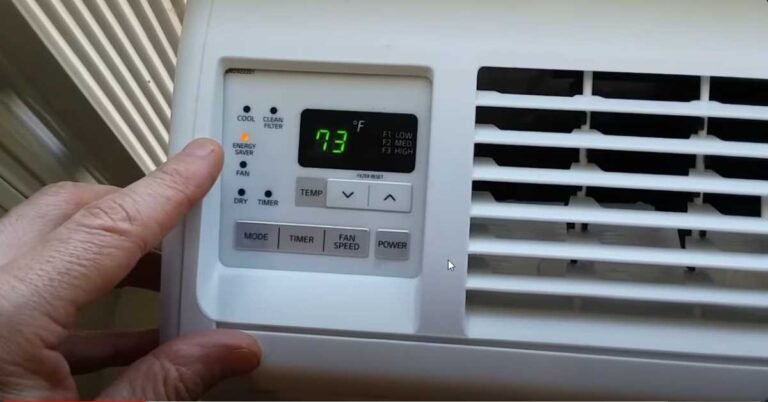What Does P1 Mean On My Portable Air Conditioner?
When you see the P1 code displayed on your portable air conditioner, it indicates a specific issue that requires attention.
Understanding what the P1 code signifies is crucial for effectively troubleshooting the problem.
By identifying the underlying cause, you can take appropriate measures to resolve it.
What Does P1 Mean On My Portable Air Conditioner?
P1 error code commonly refers to a problem with the condenser coil temperature sensor. The condenser coil is responsible for dissipating heat from the air conditioner, and the temperature sensor measures the coil’s temperature for optimal performance.
To troubleshoot this issue, you can start by checking the condenser coil for any obstructions or blockages that might be hindering its function. Clear away any debris or dirt that might have accumulated on the coil. Additionally, ensure that the air conditioner is placed in a well-ventilated area, as poor air circulation can also impact the coil’s temperature.
If the error persists after performing these basic checks, it might be necessary to seek professional assistance. Contact the manufacturer or a qualified technician to further diagnose and resolve the issue.

Troubleshooting Steps
Here is a step-by-step guide to troubleshooting the P1 code on your portable air conditioner:
1. Identify the Error: Take note of the P1 error code displayed on your air conditioner’s control panel.
2. Check for Obstructions: Clear any debris or blockages from the condenser coil to ensure proper airflow.
3. Ensure Ventilation: Place the air conditioner in a well-ventilated area, free from obstructions.
4. Reset the Unit: Turn off the air conditioner, unplug it from the power source, wait for a few minutes, then plug it back in and turn it on again.
5. Contact Customer Support: If the P1 code persists, reach out to the customer support of your air conditioner’s manufacturer for further guidance.
Prioritize your safety when troubleshooting electrical devices. If you’re unsure or uncomfortable, seek professional assistance.
When to Seek Professional Help?
Here are some guidelines on when to seek professional help if you encounter the P1 code on your portable air conditioner:
Continuous Error Display
If the P1 code continues to appear even after performing basic troubleshooting steps, consider seeking professional assistance.
Unfamiliar with Internal Components
If you’re unsure about the internal components of an air conditioner and need help troubleshooting, it’s best to contact a professional.
Lack of Technical Knowledge
If you lack the technical expertise to diagnose and resolve complex P1 code issues, it’s best to seek assistance from an expert.
Manufacturer’s Recommendations
Check the user manual or manufacturer’s guidelines for recommendations on seeking professional assistance when encountering the P1 code.
Warranty Coverage
If your portable air conditioner is still under warranty, contacting the manufacturer or authorized service center is recommended for professional repairs or assistance.

Preventive Maintenance and Tips
Preventive maintenance is vital for maintaining the performance and durability of your portable air conditioner (AC).
To avoid the P1 code issue, here are some helpful tips.
Foremost, regular cleaning or replacement of the air filters is crucial. Clogged filters restrict airflow, strain the AC, and trigger error codes like P1. Keep the filters clean to prevent dust and debris buildup.
In addition, ensure the condenser coils are free from dirt. Dirty coils reduce the AC’s efficiency, leading to overheating and error codes. Clean the coils gently using a soft cloth or brush to improve heat transfer.
Verify that the exhaust hose is securely connected and undamaged. Leaks or disconnections can disrupt the AC’s functioning, causing errors. Regularly inspect the hose for any signs of wear and tear, replacing it if needed.
Properly position the portable AC on a stable, level surface to prevent vibration or tilting. Unbalanced positioning triggers error codes like P1. Also, maintain sufficient clearance around the AC for adequate air circulation.
Give the AC periodic breaks instead of continuous operation. Resting periods prevent overheating, a common cause of error codes.
Refer to the manufacturer’s manual for specific troubleshooting instructions related to the P1 code. Each portable AC model has unique requirements and guidelines.
By following these maintenance tips, you can minimize the P1 code occurrence and ensure smooth and efficient operation of your portable AC.
Conclusion
Knowing the importance of the P1 code on your portable air conditioner is vital for effective troubleshooting. By understanding what the P1 code means, you can take the necessary steps to address the issue and ensure optimal AC performance. Timely action and proper maintenance are key to resolving problems associated with the P1 code.
To prevent the P1 code, follow the earlier mentioned preventive measures such as cleaning or replacing filters, checking condenser coils, inspecting the exhaust hose, and ensuring proper positioning. Also, consulting the manufacturer’s manual for detailed instructions and guidelines can offer valuable insights on troubleshooting.
By implementing these recommendations, you can minimize the occurrence of the P1 code and enjoy uninterrupted cooling from your portable air conditioner.






